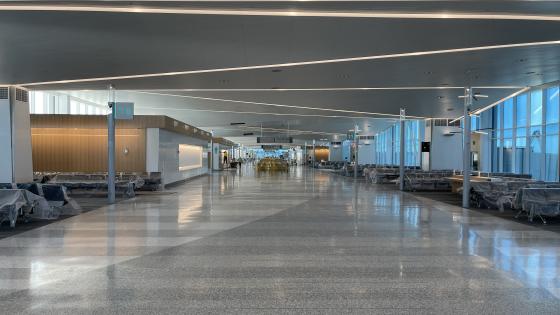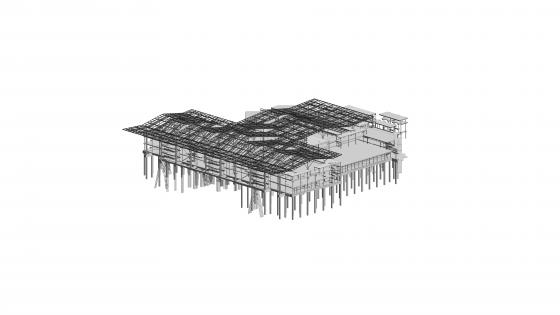Thornton Tomasetti’s Tyler Ranf and Jonathon Stage recommend a three-pronged structural approach when building sustainable airports. Here they explain why
Sustainability is much more than just collecting LEED points. While LEED certification provides a framework and a metric for improving efficiency and reducing a building’s carbon footprint, forward-thinking firms are pushing the envelope with a three-pronged approach that greatly enhances sustainable airport design.
Sustainability is much more than just collecting LEED points. While LEED certification provides a framework and a metric for improving efficiency and reducing a building’s carbon footprint, forward-thinking firms are pushing the envelope with a three-pronged approach that greatly enhances sustainable airport design.

Designs that follow this approach focus on maximising sustainability through increasing structural efficiency, improving structural resiliency, and the creative use of materials. The progress on each of these is monitored throughout the life of the project, to stay on track with the overall goals and to provide insight and expertise for future work.
Factor one: efficiency
Structural efficiency is the first part of this process and requires smart material use. However, targeting efficiency without integrating the needs of the client and airport may lead to poor designs. The intent of the structural design should be to enhance the architectural vision by elegantly integrating its presence into the structure. To achieve this, the structure must be an early factor when establishing the project’s programmatic and aesthetic goals. Early analysis provides timely data to enable the smart, sustainable, and cost-effective application of the structural system.

Jonathon Stage, Thornton Tomasetti, vice-president and West Region sustainability leader
By being proactive, a project team can ensure the structure is efficiently designed to reduce the embodied carbon while still reflecting the goals of the client and the airport. For example, in designing a new 700,000sq ft terminal at Pittsburgh International Airport, Thornton Tomasetti conducted a comprehensive analysis of the roof design. We received the architectural BIM (building information modelling) model and worked with the architectural team of Gensler in association with luis vidal + architects to define parameters that could be modified to maintain the architectural vision while increasing the efficiency and redundancy of the roof structure. By the end of this highly collaborative process, and with the use of our parametric modelling techniques, the roof structure was lighter, performed better, and was easier to construct. The lighter roof meant smaller columns and foundations, thereby saving additional material ‘downstream’.
Structures should be able to withstand weather and climate changes, future airport needs and trends, man-made threats and negligence, advances in technology, etc.
Factor two: resiliency
Resiliency is the second key consideration in a sustainable design. Structural resiliency is a measure of the building’s ability to be relevant in the future. A structure is not sustainable if it requires premature demolition or substantial modifications. Structures should be ableto withstand weather and climate changes, future airport needs and trends, man-made threats and negligence, advances in technology, etc. Over the decades, we have seen numerous accounts of airport terminals and facilities being partly or completely demolished prematurely because they restrict programmatic changes, often in the spirit of creating efficiency. Therefore, efficiency and resiliency need to be studied simultaneously so that an increase in one does not cause a decrease in the other.
There are many ways of increasing resiliency. Examples of this includes encasing steel columns with concrete in critical areas and locations where there is vehicular use, to protect them from intentional or unintentional damage; designing floors for an enveloped vibration criteria to facilitate future occupancy changes; and prioritisinglarge framing bays to minimise obstructive columns.

A column-free concourse at Memphis Airport Concourse B
One way of promoting future programmatic resiliency is to design wide open spaces that are free to be changed when needed, by concentrating the necessary structure where changes are less likely to take place. In a terminal, for example, landside spaces like ticketing, bag claim, and TSA screening, and airside spaces such as concessions and circulation, are all very fluid and likely to change throughout the life of the building. Therefore, these should be designed as open, column-free areas that can easily be reprogrammed without being restricted by structure.
Conversely, often there are areas between the landside and airside that are populated by back-of-house functions, such as administration offices, mechanical rooms, restrooms, vertical circulation, etc. These areas are generally not as fluid and can accommodate a denser structure.
Our work on the Concourse B Modernization Project at Memphis International Airport is an example of how to concentrate structure in a concourse to maximise flexibility. The necessary structure was placed below the concourse, which allowed for a light and column-free structure within the programme area above it. This resulted in column-free hold rooms, concession areas, and restroom blocks, all of which can be easily adapted to meet future programmatic needs.
Factor three: materials
Structural material use and selection is the final prong of a design approach toward a sustainable structure. The materials selected early in a project can play a key role in its sustainability. Being creative and looking to the industry for innovative low-carbon alternatives is a great way of reducing the carbon footprint. Early in the design process of the Pittsburgh Terminal Modernization Program, Thornton Tomasetti decided to use high-strength steel columns to support the roof and high-strength concrete grade beams and slabs at the apron level to span over the existing tunnels below the building. This helped to reduce the overall structural quantities and embodied carbon.
The ability to reduce the embodied carbon in the design process is maximised if the embodied carbon can be categorised and tracked throughout the life of the project
Once the design has been established, materials can be investigated for how they can best be sourced to reduce their carbon footprint. There may be an opportunity to source steel and rebar from manufacturing facilities that use more eco-friendly energy sources, such as hydropower or photovoltaics, or to use concrete products that capture and sequester carbon. When sending out construction documents for bid and procurement, it is important that specifications provide flexibility to ensure that the designer receives what is needed while enabling the contractors to creatively reduce embodied carbon based on their knowledge and strengths.
Thornton Tomasetti has shifted towards a performance-based specification for this very reason. For example, when specifying concrete, the required strength and shrinkage properties should be indicated, but the concrete subcontractor could be allowed to propose a mix that reduces the amount of cement by adjusting slump, material substitutions, age at required strength, water-cement ratio, and so on.

Beacon enables the measuring and tracking of embodied carbon
The ability to reduce the embodied carbon in the design process is maximised if the embodied carbon can be categorised and tracked throughout the life of the project. Thornton Tomasetti uses programmes such as Beacon, an open-source Revit plug-in that was developed by our CORE studio (a virtual incubator of ideas), to establish a structural embodied carbon baseline for each project, then tracks carbon reduction throughout the life of the project. By tracking embodied carbon for each component of the structure (floor, framing, columns, walls, foundation, etc.), the design team can determine how each project decision helps reduce embodied carbon, and where to concentrate resources to maximise reduction efforts. For example, if 30% of the embodied carbon is in the structural framing, then time should be spent investigating added efficiencies, alternate materials, or smarter specifications to minimise it.
By using the three-pronged approach of integrating efficiency, resiliency, and material use throughout the life of the project, the team can ensure that a structure is sustainable in both the short and long term. Accounting for embodied carbon throughout the life of the project enables the team to maximise this sustainability effort for the current project and provide baselines and targets for future ones.
Efficiency and resiliency need to be studied simultaneously so that an increase in one does not cause a decrease in the other
